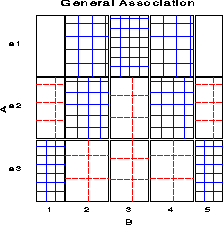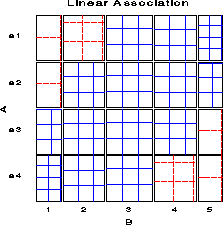However, more powerful analyses are often available:
Consider the data below, which compares a treatment for rheumatoid arthritis to a placebo (Koch & Edwards, 1998). The outcome reflects whether individuals showed no improvement, some improvement, or marked improvement.
| Outcome
---------+---------+--------------------------+
Treatment| Sex |None |Some |Marked | Total
---------+---------+--------+--------+--------+
Active | Female | 6 | 5 | 16 | 27
| Male | 7 | 2 | 5 | 14
---------+---------+--------+--------+--------+
Placebo | Female | 19 | 7 | 6 | 32
| Male | 10 | 0 | 1 | 11
---------+---------+--------+--------+--------+
Total 42 14 28 84
Here, the outcome variable is an ordinal one, and it is probably
important to determine if the relation between treatment and outcome
is the same for males and females.
title 'Arthritis Treatment: PROC FREQ Analysis';
data arth;
input sex $ treat $ @;
do improve = 'None ', 'Some', 'Marked';
input count @;
output;
end;
cards;
Female Active 6 5 16
Female Placebo 19 7 6
Male Active 7 2 5
Male Placebo 10 0 1
;
*-- Ignoring sex;
proc freq order=data;
weight count;
tables treat * improve / cmh chisq nocol nopercent;
run;
Notes:
TABLE OF TREAT BY IMPROVE
TREAT IMPROVE
Frequency|
Row Pct |None |Some |Marked | Total
---------+--------+--------+--------+
Active | 13 | 7 | 21 | 41
| 31.71 | 17.07 | 51.22 |
---------+--------+--------+--------+
Placebo | 29 | 7 | 7 | 43
| 67.44 | 16.28 | 16.28 |
---------+--------+--------+--------+
Total 42 14 28 84
The results for the chisq option is shown below. All tests
show a significant association between treatment and outcome.
+-------------------------------------------------------------------+ | | | STATISTICS FOR TABLE OF TREAT BY IMPROVE | | | | Statistic DF Value Prob | | ------------------------------------------------------ | | Chi-Square 2 13.055 0.001 | | Likelihood Ratio Chi-Square 2 13.530 0.001 | | Mantel-Haenszel Chi-Square 1 12.859 0.000 | | Phi Coefficient 0.394 | | Contingency Coefficient 0.367 | | Cramer's V 0.394 | | | +-------------------------------------------------------------------+
For the arthritis data, these tests ( cmh option) give the following output.
+-------------------------------------------------------------------+ | | | SUMMARY STATISTICS FOR TREAT BY IMPROVE | | | | Cochran-Mantel-Haenszel Statistics (Based on Table Scores) | | | | Statistic Alternative Hypothesis DF Value Prob | | -------------------------------------------------------------- | | 1 Nonzero Correlation 1 12.859 0.000 | | 2 Row Mean Scores Differ 1 12.859 0.000 | | 3 General Association 2 12.900 0.002 | | | +-------------------------------------------------------------------+The three types of tests differ in the types of departure from independence they are sensitive to:
| b1 | b2 | b3 | b4 | b5 | Total Mean
--------+-------+-------+-------+-------+-------+
a1 | 0 | 15 | 25 | 15 | 0 | 55 3.0
a2 | 5 | 20 | 5 | 20 | 5 | 55 3.0
a3 | 20 | 5 | 5 | 5 | 20 | 55 3.0
--------+-------+-------+-------+-------+-------+
Total 25 40 35 40 25 165
This is reflected in the PROC FREQ output:
+-------------------------------------------------------------------+ | | | Cochran-Mantel-Haenszel Statistics (Based on Table Scores) | | | | Statistic Alternative Hypothesis DF Value Prob | | -------------------------------------------------------------- | | 1 Nonzero Correlation 1 0.000 1.000 | | 2 Row Mean Scores Differ 2 0.000 1.000 | | 3 General Association 8 91.797 0.000 | | | +-------------------------------------------------------------------+
| b1 | b2 | b3 | b4 | b5 | Total Mean
--------+-------+-------+-------+-------+-------+
a1 | 2 | 5 | 8 | 8 | 8 | 31 3.48
a2 | 2 | 8 | 8 | 8 | 5 | 31 3.19
a3 | 5 | 8 | 8 | 8 | 2 | 31 2.81
a4 | 8 | 8 | 8 | 5 | 2 | 31 2.52
--------+-------+-------+-------+-------+-------+
Total 17 29 32 29 17 124
Note that the chi² -values for the row-means and
non-zero correlation tests are very similar, but the correlation test
is more highly significant.
+-------------------------------------------------------------------+ | | | Cochran-Mantel-Haenszel Statistics (Based on Table Scores) | | | | Statistic Alternative Hypothesis DF Value Prob | | -------------------------------------------------------------- | | 1 Nonzero Correlation 1 10.639 0.001 | | 2 Row Mean Scores Differ 3 10.676 0.014 | | 3 General Association 12 13.400 0.341 | | | +-------------------------------------------------------------------+The differences in sensitivity and power among these tests is analogous to the difference between general ANOVA tests and tests for linear trend in experimental designs with quantitative factors.


A stratified analysis
tables age * sex * treat * improve;
*-- Stratified analysis, controlling for sex; proc freq order=data; weight count; tables sex * treat * improve / cmh chisq nocol nopercent; run;PROC FREQ gives a separate table for each level of the stratification variables, plus overall (partial) tests controlling for the stratification variables.
TABLE 1 OF TREAT BY IMPROVE
CONTROLLING FOR SEX=Female
TREAT IMPROVE
Frequency|
Row Pct |None |Some |Marked | Total
---------+--------+--------+--------+
Active | 6 | 5 | 16 | 27
| 22.22 | 18.52 | 59.26 |
---------+--------+--------+--------+
Placebo | 19 | 7 | 6 | 32
| 59.38 | 21.88 | 18.75 |
---------+--------+--------+--------+
Total 25 12 22 59
STATISTICS FOR TABLE 1 OF TREAT BY IMPROVE
CONTROLLING FOR SEX=Female
Statistic DF Value Prob
------------------------------------------------------
Chi-Square 2 11.296 0.004
Likelihood Ratio Chi-Square 2 11.731 0.003
Mantel-Haenszel Chi-Square 1 10.935 0.001
Phi Coefficient 0.438
Contingency Coefficient 0.401
Cramer's V 0.438
Note that the association between treatment and outcome is quite
strong for females. In contrast, the results for males (below) shows
a non-significant association, even by the Mantel-Haenzsel test; but
note that there are too few males for the general association
chi² tests to be reliable (the statistic does not follow
the theoretical chi² distribution).
TABLE 2 OF TREAT BY IMPROVE
CONTROLLING FOR SEX=Male
TREAT IMPROVE
Frequency|
Row Pct |None |Some |Marked | Total
---------+--------+--------+--------+
Active | 7 | 2 | 5 | 14
| 50.00 | 14.29 | 35.71 |
---------+--------+--------+--------+
Placebo | 10 | 0 | 1 | 11
| 90.91 | 0.00 | 9.09 |
---------+--------+--------+--------+
Total 17 2 6 25
STATISTICS FOR TABLE 2 OF TREAT BY IMPROVE
CONTROLLING FOR SEX=Male
Statistic DF Value Prob
------------------------------------------------------
Chi-Square 2 4.907 0.086
Likelihood Ratio Chi-Square 2 5.855 0.054
Mantel-Haenszel Chi-Square 1 3.713 0.054
Phi Coefficient 0.443
Contingency Coefficient 0.405
Cramer's V 0.443
WARNING: 67% of the cells have expected counts less
than 5. Chi-Square may not be a valid test.
The individual tables are followed by the (overall) partial tests of
association controlling for sex. Unlike the tests for each strata,
these tests do not require large sample size in the
individual strata -- just a large total sample size. Note that the
chi² values here are slightly larger than those from
the initial analysis that ignored sex.
+--------------------------------------------------------------------+ | | | SUMMARY STATISTICS FOR TREAT BY IMPROVE | | CONTROLLING FOR SEX | | | | Cochran-Mantel-Haenszel Statistics (Based on Table Scores) | | | | Statistic Alternative Hypothesis DF Value Prob | | -------------------------------------------------------------- | | 1 Nonzero Correlation 1 14.632 0.000 | | 2 Row Mean Scores Differ 1 14.632 0.000 | | 3 General Association 2 14.632 0.001 | | | +--------------------------------------------------------------------+
For the arthritis data, homogeneity means that there is no three-way sex * treatment * outcome association. This hypothesis can be stated as is the loglinear model,
[SexTreat] [SexOutcome] [TreatOutcome],which allows associations between sex and treatment (e.g., more males get the Active treatment) and between sex and outcome (e.g. females are more likely to show marked improvement). In the PROC CATMOD step below, the loglin statement specifies this log-linear model as sex|treat|improve@2 which means "all terms up to 2-way associations".
title2 'Test homogeneity of treat*improve association';
data arth;
set arth;
if count=0 then count=1E-20;
proc catmod order=data;
weight count;
model sex * treat * improve = _response_ /
ml noiter noresponse nodesign nogls ;
loglin sex|treat|improve@2 / title='No 3-way association';
run;
loglin sex treat|improve / title='No Sex Associations';
(Frequencies of zero can be regarded as either "structural
zeros"--a cell which could not occur, or as "sampling
zeros"--a cell which simply did not occur. PROC CATMOD treats
zero frequencies as "structural zeros", which means that
cells with count = 0 are excluded from the analysis. The
DATA step above replaces the one zero frequency by a small number.)
In the output from PROC CATMOD, the likelihood ratio chi² (the badness-of-fit for the No 3-Way model) is the test for homogeneity across sex. This is clearly non-significant, so the treatment-outcome association can be considered to be the same for men and women.
+-------------------------------------------------------------------+ | | | Test homogeneity of treat*improve association | | No 3-way association | | MAXIMUM-LIKELIHOOD ANALYSIS-OF-VARIANCE TABLE | | | | Source DF Chi-Square Prob | | -------------------------------------------------- | | SEX 1 14.13 0.0002 | | TREAT 1 1.32 0.2512 | | SEX*TREAT 1 2.93 0.0871 | | IMPROVE 2 13.61 0.0011 | | SEX*IMPROVE 2 6.51 0.0386 | | TREAT*IMPROVE 2 13.36 0.0013 | | | | LIKELIHOOD RATIO 2 1.70 0.4267 | | | +-------------------------------------------------------------------+Note that the associations of sex with treatment and sex with outcome are both small and of borderline significance, which suggests a stronger form of homogeneity, the log-linear model [Sex] [TreatOutcome] which says the only association is that between treatment and outcome. This model is tested by the second loglin statement given above, which produced the following output. The likelihood ratio test indicates that this model might provide a reasonable fit.
+-------------------------------------------------------------------+ | | | No Sex Associations | | MAXIMUM-LIKELIHOOD ANALYSIS-OF-VARIANCE TABLE | | | | Source DF Chi-Square Prob | | -------------------------------------------------- | | SEX 1 12.95 0.0003 | | TREAT 1 0.15 0.6991 | | IMPROVE 2 10.99 0.0041 | | TREAT*IMPROVE 2 12.00 0.0025 | | | | LIKELIHOOD RATIO 5 9.81 0.0809 | | | +-------------------------------------------------------------------+